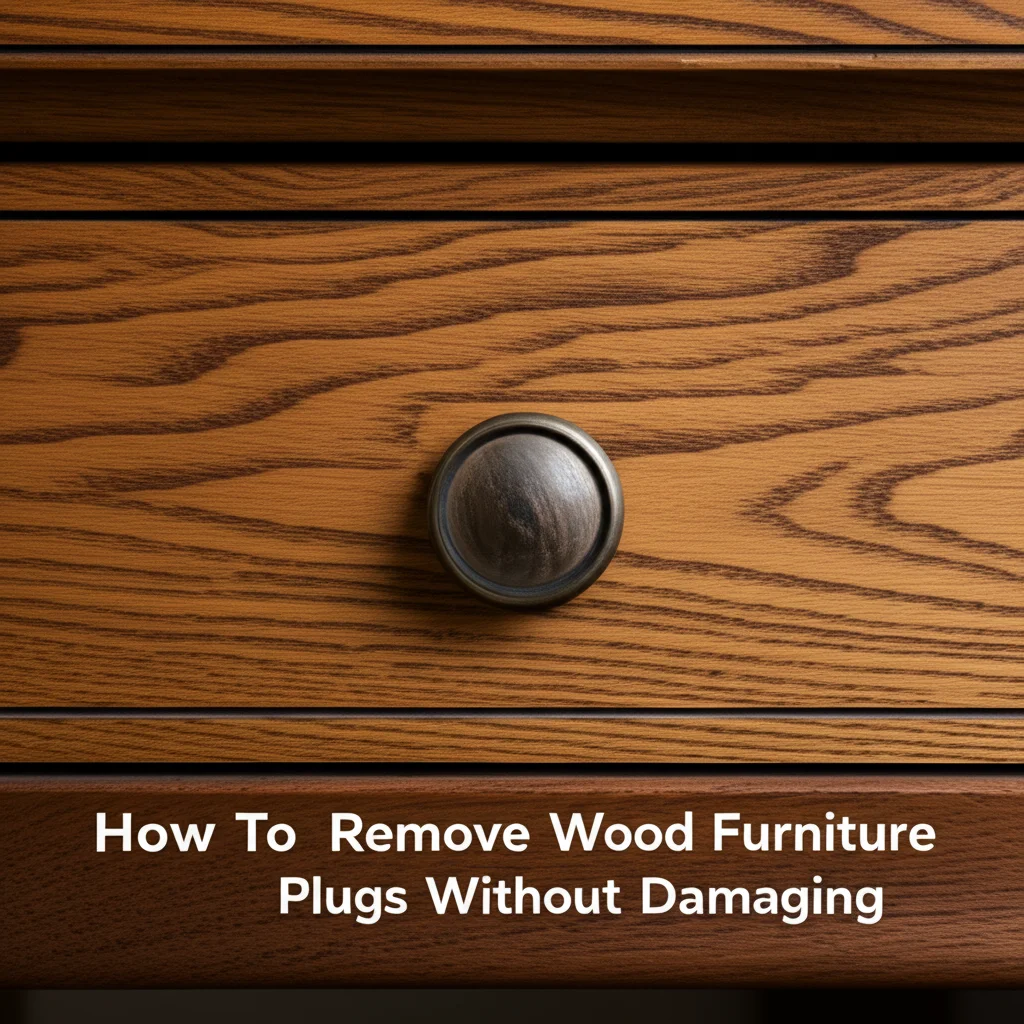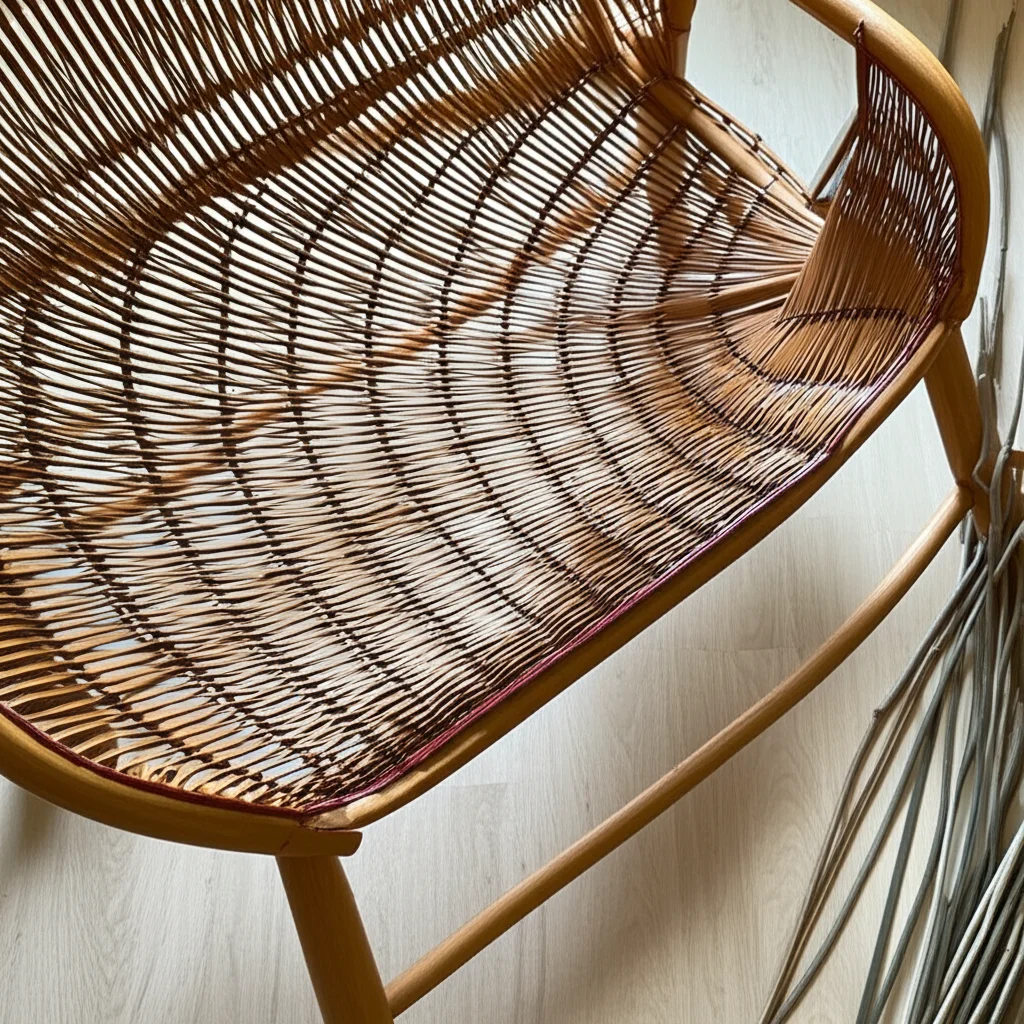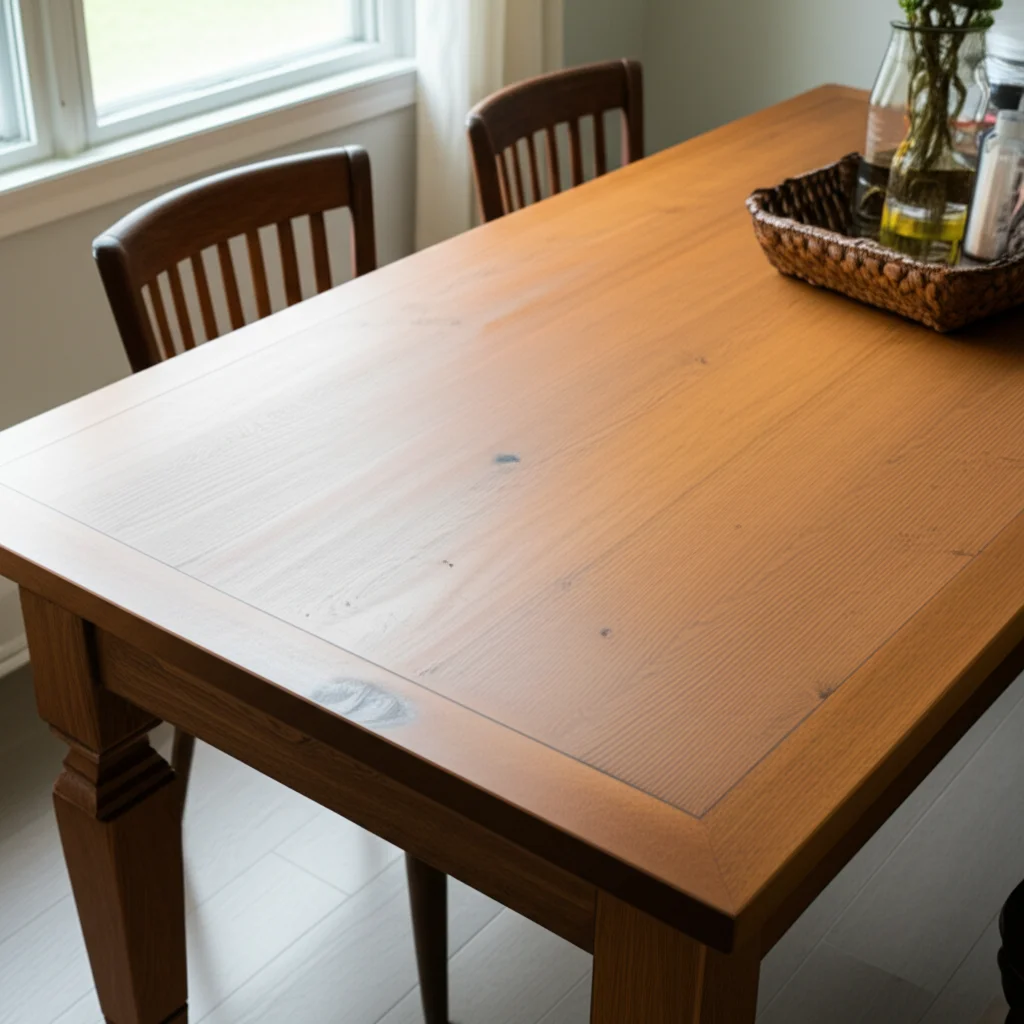· Todd Martin · Furniture Repair & Maintenance · 21 min read
How To Remove Wood Furniture Plugs Without Damaging

Remove Wood Furniture Plugs Safely
Have you ever looked at a beautiful piece of wooden furniture and noticed those small, circular wood plugs? Sometimes, these plugs need to come out. Maybe you plan a repair, want to disassemble an item, or simply desire a cleaner look. Removing wood furniture plugs without damage feels like a tricky task. I understand your concern; damaging wood furniture during a simple plug removal is a real fear. It requires care, the right tools, and a clear approach. This guide will show you how to remove wood furniture plugs safely. We will cover the different types of plugs, necessary tools, and step-by-step methods. You will learn to approach this task with confidence, keeping your furniture safe and looking its best.
Takeaway:
- Identify the type of wood plug before you begin.
- Gather the correct, sharp tools for the job.
- Work slowly and apply gentle, steady pressure.
- Understand the plug’s purpose and how it attaches.
- Prepare the surrounding wood to prevent scratches or dents.
Removing wood furniture plugs without damage requires precise tools and careful technique. You must first identify the plug type, then select tools like chisels, utility knives, or drills. Apply gentle pressure, working slowly to loosen or cut the plug from its housing. This method keeps the surrounding wood safe.
Understanding Wood Plugs and Their Purpose
Wood furniture plugs serve several important functions in furniture construction. They often hide screw heads or bolt holes, creating a clean and finished appearance. Plugs can also provide structural integrity, preventing screws from backing out or reinforcing joints. When you see a plug, it usually covers a fastener. This means it is likely glued or pressed firmly into place.
Knowing why a plug exists helps you remove it without harm. Some plugs are purely decorative. Others are crucial to the furniture’s stability. Identifying the plug type is the first step in successful removal. They come in different forms, each requiring a specific approach. Some are flush with the surface, while others are slightly recessed or domed. Understanding these differences prevents mistakes. For example, a decorative plug might come out more easily than one holding a main structural screw.
Types of Wood Plugs
- Flush Plugs: These plugs sit perfectly level with the wood surface. They often hide screw heads. Removing them usually involves prying or drilling carefully.
- Recessed Plugs: These plugs sit slightly below the surface. They might cover screws that need deeper countersinking. A small chisel or pick works well here.
- Domed or Button Plugs: These plugs have a rounded top. They add a decorative touch. You can often pry them out using a thin tool under the edge.
- Through Plugs: Sometimes, a plug goes all the way through a piece of wood. This is common in outdoor furniture. You might need to push these from the other side.
Each type of plug has its own removal challenge. Consider the wood type of your furniture too. Hardwoods react differently than softwoods. This impacts how much force you can use. Assess the plug’s appearance and the surrounding wood before you even touch a tool. This assessment prepares you for the task ahead.
Essential Tools for Damage-Free Plug Removal
Choosing the right tools makes all the difference when you remove wood furniture plugs. Using incorrect tools often results in damage to the surrounding wood or the plug itself. I always gather my tools first. A clean, organized workspace also helps. Sharp tools are a must. Dull tools require more force, which increases the chance of slipping or damaging the wood.
You do not need a huge collection of tools for this task. A few specialized items, combined with common household tools, will suffice. Safety gear is also important. Always wear eye protection. Small wood splinters can fly. Protect your hands with gloves if you are using sharp chisels.
Key Tools You Need
- Sharp Wood Chisels: A set of sharp chisels, ranging from 1/4 inch to 1/2 inch, is invaluable. They allow precise cuts.
- Utility Knife or Craft Knife: A sharp blade can score around the plug, preventing tear-out.
- Small Pry Bar or Trim Puller: For plugs that can be gently lifted. Choose one with a thin, flat edge.
- Drill with Forstner Bit or Brad-Point Bit: For drilling out plugs or creating pilot holes. Use a bit slightly smaller than the plug’s diameter.
- Pliers (Needle-Nose or Diagonal Cutters): Useful for gripping and pulling if a plug lifts enough.
- Wood Glue: For any minor repairs or re-securing elements later.
- Sandpaper (Fine Grit): For smoothing any rough edges after removal.
- Soft Mallet or Hammer: For gently tapping chisels, if needed.
Having these tools ready saves time and frustration. Quality tools perform better and last longer. Remember, the goal is to remove the plug without damaging the furniture. Each tool serves a specific purpose in this process. Make sure your chisels are razor sharp for clean cuts. Cleaning wooden furniture after a project like this helps restore its look.
Preparing Your Furniture for Plug Removal
Preparation is a crucial step before you remove wood furniture plugs. It protects your furniture and makes the job easier. I always start by cleaning the area around the plug. Dust and grime can hide small details or cause tools to slip. A clean surface gives you a clear view of the plug and the surrounding grain.
Next, assess the plug’s condition and the wood around it. Look for any existing damage like cracks or swelling. This informs your approach. You might need to reinforce weak areas before attempting removal. Proper preparation minimizes the risk of new damage.
Steps for Effective Furniture Preparation
- Clean the Surface: Use a soft cloth to wipe away dust and debris around the plug. For stubborn dirt, a slightly damp cloth with mild soap works. Ensure the wood is dry before starting work. Learn more about cleaning wood furniture with vinegar for effective cleaning methods.
- Inspect the Plug and Surrounding Wood: Look closely at how the plug sits. Is it flush, recessed, or domed? Check for any visible glue lines or gaps. Note the wood grain direction. This helps you anticipate how the wood will react to pressure.
- Identify the Wood Type: Knowing if your furniture is made from hardwood (like oak or maple) or softwood (like pine) helps. Hardwoods are more durable but can split if too much force is used. Softwoods dent more easily. If you are unsure, read about how to tell if furniture is real wood.
- Protect Nearby Areas: Use painter’s tape or masking tape to mark off the area immediately surrounding the plug. This creates a visual boundary. It also helps prevent accidental scratches from your tools. You can also place a thin piece of cardboard or wood veneer next to the plug as a guard.
- Stabilize the Furniture: Ensure the furniture piece is stable. If it wobbles, secure it. Use clamps or place it on a sturdy workbench. This prevents movement that could lead to slips and damage. A stable surface allows you to apply force precisely.
Taking these preparatory steps adds a few minutes to your process. However, it saves you from potential repairs or disappointment later. A little planning goes a long way. This careful approach helps you maintain the integrity of your wood furniture.
Techniques for Removing Flush and Recessed Plugs
Removing flush and recessed wood plugs demands specific techniques to avoid damage. These plugs often fit tightly and may be glued. My general rule is to start with the least invasive method. Increase intensity only if necessary. Patience is key here. Rushing often leads to mistakes.
Flush plugs sit level with the wood surface. Recessed plugs sit slightly below. Both require precision. The goal is to separate the plug from the surrounding wood without tearing out fibers or creating unsightly gouges.
Removing Flush Wood Plugs
Flush plugs are perhaps the trickiest because they offer no edge to grip.
- Score Around the Plug: Use a sharp utility knife or craft knife. Carefully score the outline of the plug. Hold the blade vertically. Make several passes, applying gentle pressure. This cuts through any finish or glue holding the plug. It also prevents wood tear-out when the plug is removed.
- Gentle Prying (If Applicable): Sometimes, scoring alone can loosen a flush plug enough. If you see a tiny gap, try to gently insert a very thin, flat tool, like a razor blade or a thin painter’s scraper. Wiggle it slightly to see if the plug lifts.
- Drilling Technique: This is often the most reliable method for flush plugs.
- Select a Bit: Choose a drill bit (Forstner or brad-point) that is slightly smaller than the plug’s diameter. The bit should cut the center of the plug, leaving the edges intact.
- Drill a Shallow Hole: Place the tip of the drill bit in the center of the plug. Drill a shallow hole, just deep enough to weaken the plug’s core. Do not drill through the furniture.
- Chisel Out the Remainder: Use a sharp chisel (matching the plug’s radius if possible) to carefully pry out the weakened plug material. Work from the center outwards. You can also make a series of small cuts around the edge of the drilled hole, then break the plug into pieces.
- Clean the Hole: Once the plug is out, use the chisel to scrape away any remaining glue or wood fibers. A quick clean-up ensures the hole is ready for its next purpose.
Removing Recessed Wood Plugs
Recessed plugs offer a small advantage: a slight edge to work with.
- Clear Debris: First, clean any dirt or debris from the recessed area. Use a small pick or compressed air.
- Prying with a Small Chisel or Pick: Insert a small, sharp wood chisel or a sturdy awl under the edge of the recessed plug. Angle the tool slightly. Apply gentle upward pressure. Try to lift one side of the plug first.
- Work Around the Edge: Once one side lifts slightly, move your tool around the perimeter of the plug. Continue to apply gentle, steady pressure to loosen it evenly. Avoid forcing it from just one side, as this can crack the plug or the surrounding wood.
- Use Pliers (If Needed): If the plug lifts enough to grip, use needle-nose pliers to gently pull it straight out. Twist slightly if needed, but do not yank.
- Drilling as a Last Resort: If the plug is stubbornly glued, or very deep, you can use the drilling technique described for flush plugs. Be extra careful not to damage the sides of the recessed hole.
Remember to work slowly. Always test the plug’s resistance before applying more force. This minimizes the chance of damaging your wood furniture. After removing the plug, you may want to learn how to fix a crack in wood furniture if any minor damage occurs. For general wood care after your project, consider how to clean stains on wood.
Handling Stubborn or Glued-In Plugs
Sometimes, wood furniture plugs are exceptionally stubborn. They might be heavily glued or swollen from moisture. This requires a more patient and strategic approach. My personal rule for these tough cases is to add a step, not more force. Excessive force can quickly lead to irreversible damage to your furniture.
These plugs test your patience. However, with the right methods, you can remove them without harm. The key is to weaken the glue or wood fibers holding the plug without impacting the surrounding material. Always re-evaluate your approach if the plug does not move with gentle effort.
Strategies for Stubborn Plugs
- Heat Application (Caution!):
- Purpose: Heat can soften some types of wood glue.
- Method: Use a hairdryer on a low or medium setting. Hold it a few inches from the plug. Apply heat for 30-60 seconds.
- Caution: Monitor the wood carefully. Do not overheat, as this can damage the finish or scorch the wood. Test the plug with a tool after applying heat. Repeat if needed. This method is best for small amounts of glue.
- Moisture Application (For Swollen Wood or PVA Glue):
- Purpose: Water can swell wood or reactivate certain glues (like PVA/white wood glue).
- Method: Apply a small amount of water to the plug using a cotton swab or eyedropper. Let it sit for 10-15 minutes.
- Caution: Use very little water. Excessive moisture can cause swelling or damage to the surrounding wood and finish. This method is risky for veneer or antique pieces.
- Drill and Disintegrate:
- Purpose: For plugs that are too tight to pry.
- Method: Use a drill bit (a Forstner bit is ideal) that is slightly smaller than the plug’s diameter. Drill shallow, overlapping holes inside the plug, but avoid the edges. The goal is to break the plug into small pieces.
- Caution: Stop drilling often to check your depth and progress. Do not drill through the furniture. Once the center is compromised, you can often chip out the remaining pieces with a small chisel or pick. This is a very effective method for deeply set plugs.
- Chemical Solvents (Last Resort and Extreme Caution):
- Purpose: To dissolve specific types of glue.
- Method: Only use if you know the type of glue and have researched an appropriate solvent. Apply a tiny amount with a cotton swab. Let it sit.
- Caution: This is a high-risk method. Solvents can strip finishes, stain wood, or even damage the wood fibers. Always test in an inconspicuous area first. Ensure good ventilation. This is usually not recommended for furniture unless you are an experienced restorer.
- Sequential Drilling and Scoring:
- Purpose: A combination approach for very stubborn plugs.
- Method: First, score around the plug deeply with a utility knife. Then, drill a series of small pilot holes around the circumference of the plug, just inside your scored line. Do not go through the furniture. These holes weaken the plug’s attachment points. Now, try prying with a small chisel. The plug should come out in sections or as a whole.
When dealing with very stubborn plugs, remember that patience and incremental steps are your best allies. You might need to combine a few of these methods. Always prioritize the safety of your furniture. For cases of water damage or swelling that might have contributed to the plug’s stubbornness, understanding how to fix water damaged swollen wood furniture could be useful for overall restoration.
Post-Removal Care and Finishing Touches
Once you successfully remove the wood furniture plugs, your work is not entirely done. The post-removal care and finishing touches are vital. They ensure the furniture looks its best and remains protected. I always take time for this final stage. It fixes any small imperfections and prepares the area for its next purpose, whether that is a new plug, a fastener, or simply a clean hole.
This step is where you address any minor nicks, scrapes, or glue residue. Proper finishing ensures the area blends seamlessly with the rest of the furniture. Skipping this part can leave your furniture looking unfinished or even damaged.
Steps for Post-Removal Care
- Clean the Plug Hole: Use a small chisel, craft knife, or sandpaper (wrapped around a dowel or finger) to scrape away any remaining glue or wood fibers inside the hole. The goal is a clean, smooth opening.
- Smooth Rough Edges: Gently sand any rough edges or raised grain around the outside of the hole. Use fine-grit sandpaper (220-grit or higher). Sand lightly in the direction of the wood grain. This prevents splinters and makes the area smooth to the touch.
- Address Minor Scratches or Dents:
- Small Scratches: For light surface scratches, a wood repair marker or scratch cover polish can often hide them.
- Dents: Small dents can sometimes be raised by applying a damp cloth and a hot iron for a few seconds. The steam causes the wood fibers to swell. How to fix a crack in wood furniture offers more detail on wood repair.
- Apply Finish (If Needed): If you exposed raw wood or want the area to match the surrounding finish, apply a small amount of stain, varnish, or oil.
- Matching: Test the finish in an inconspicuous area first to ensure it matches. Apply thin coats.
- Blending: Feather the finish outward from the hole to blend it with the existing surface.
- Insert New Plugs or Fasteners (If Applicable): If you are inserting new plugs, ensure they fit snugly. Apply a small amount of wood glue to the sides of the new plug. Tap it gently into place with a mallet. Wipe away any excess glue immediately. If you are inserting a new screw or bolt, ensure the hole is clear and secure.
- Overall Furniture Cleaning: After completing the work, give the entire piece of furniture a good cleaning. This removes any dust or residue from the repair. You can learn more about general wood cleaning tips by checking out resources on how to clean a wood table. A thorough clean enhances the overall appearance of your furniture.
These finishing touches are essential for a professional result. They ensure your furniture looks as good as new, or even better, after the plug removal process.
Common Mistakes to Avoid When Removing Plugs
Removing wood furniture plugs sounds simple, but many common mistakes can lead to damage. I have seen them all. Avoiding these pitfalls is as important as knowing the right techniques. Awareness helps you prevent damage. Haste is often the biggest enemy in this process.
Taking shortcuts or using the wrong tools often causes problems. A little forethought saves you from costly repairs. Remember, the goal is to remove the plug without harming the surrounding wood.
Mistakes to Watch Out For:
- Using Dull Tools: A dull chisel or knife will tear wood fibers instead of cutting them cleanly. This results in ragged edges and damage around the plug hole. Always ensure your tools are razor sharp before starting.
- Applying Excessive Force: This is the most common mistake. Yanking, twisting, or forcing a stubborn plug can split the surrounding wood. It can also cause deep gouges. Work slowly. Increase pressure only incrementally.
- Not Scoring Around the Plug: Failing to score the perimeter of a plug is a major oversight. This score line acts as a barrier, preventing the finish or wood grain from tearing away from the main surface. Always score around the plug, especially with flush or glued-in plugs.
- Drilling Too Deep or Off-Center: If you use a drill, drilling too deep can go through the furniture. Drilling off-center can damage the sides of the plug hole. Use a drill stop or mark your drill bit depth. Center your bit carefully.
- Ignoring Wood Grain Direction: When chiseling, always work with the wood grain, not against it. Working against the grain causes tear-out. This leaves rough, splintered edges.
- Not Protecting the Surrounding Area: Failing to tape off or guard the area around the plug can lead to accidental scratches or dents from your tools. A little painter’s tape or a piece of thin cardboard provides protection.
- Rushing the Process: Patience is a virtue in furniture repair. Each plug might present a unique challenge. Take your time. If you feel frustrated, take a break.
- Using the Wrong Type of Tool for the Plug: A small screwdriver is not a good substitute for a sharp chisel when removing a flush plug. Each plug type benefits from specific tools. Using the wrong tool can cause more harm than good.
- Failing to Clean the Area First: Dirt, dust, or old finishes can obscure your view and cause tools to slip. A clean surface allows for better precision.
By being mindful of these common mistakes, you increase your chances of a successful, damage-free plug removal. It protects your furniture and makes the repair process smoother.
Restoring Furniture After Plug Removal: Beyond the Basics
Once you have successfully removed the wood furniture plugs, you might consider further steps. Sometimes, the goal is not just removal but a complete restoration. This goes beyond simple cleaning and smoothing. It addresses the overall look and longevity of your furniture. I find it rewarding to take a piece from functional repair to renewed beauty.
This section covers more involved aspects of restoration. It helps integrate the repaired area into the furniture’s original appearance or prepare it for a new one.
Advanced Restoration Considerations
- Filling Holes: If you do not plan to reinsert new plugs or fasteners, you might want to fill the holes.
- Wood Filler: For small holes, wood filler works well. Choose a color that matches your wood or one that can be stained. Apply in thin layers.
- Wood Dowels/Plugs (Custom): For larger holes or a more natural look, you can cut custom wood dowels or plugs from matching wood. Glue them in place. Sand them flush once dry.
- Refinishing the Area: If the plug removal caused any finish damage, or if you plan to change the look of your furniture, you might need to refinish the area.
- Spot Refinishing: For minor areas, carefully sand the damaged finish. Apply new stain or varnish. Try to feather the edges to blend with the existing finish. This requires practice.
- Full Refinishing: If the entire piece needs a refresh, consider how to remove varnish from wood with vinegar as a stripping method. Then, apply a new finish. This gives your furniture a completely new lease on life.
- Color Matching: When refinishing or patching, color matching is crucial. Different wood species absorb stain differently. Test stains on scrap wood of the same type. Allow it to dry completely. The color changes when dry.
- Addressing Underlying Issues: Sometimes, plugs hide problems like water damage or rot.
- Water Damage: If you discover swollen wood or water stains, address them immediately. Learn about how to fix water damaged swollen wood furniture. Timely action prevents further deterioration.
- Mold/Mildew: If you find mold, you must clean it thoroughly. Resources on how to clean mold off of wood furniture can guide you.
- Protecting the Wood: Once restored, protect your wood furniture. Apply a good quality wax or furniture polish. This protects the finish and keeps the wood hydrated. Regular cleaning, using mild products, extends the life of your furniture.
These advanced steps transform a simple plug removal into a true furniture restoration project. They help preserve the beauty and value of your wooden pieces for years to come.
When to Seek Professional Help
Even with the best instructions and tools, some wood furniture plug removal tasks prove too challenging. Knowing when to call a professional is important. Attempting a repair beyond your skill level can cause irreparable damage. I always advise people to assess their comfort level before starting. If uncertainty looms, professional help is the smart choice.
Professionals have specialized tools, extensive experience, and an understanding of different wood types and finishes. They can often solve problems quickly and efficiently. This saves you time, frustration, and potential damage costs.
Signs It’s Time for a Pro:
- Valuable or Antique Furniture: If the furniture piece is an antique, highly valuable, or has sentimental importance, do not risk it. Professionals specialize in preserving these items. They know how to handle delicate finishes and aged wood.
- Plug is Stuck and Causing Damage: If you have tried gentle methods and the plug remains stuck, and you notice the surrounding wood beginning to splinter or crack, stop immediately. Continuing might worsen the damage.
- Unusual Plug Construction: Some furniture pieces, especially custom or very old ones, may have unique plug designs or hidden fastening methods. If the plug does not respond to standard removal techniques, a pro can identify its construction.
- Fear of Damaging the Finish: If the furniture has a very delicate, unique, or unrepairable finish, the risk of scratching or marring it during plug removal is high. A professional can often minimize this risk.
- Lack of Proper Tools or Expertise: If you do not have the right tools, or if you feel unsure about any step, it is better to consult an expert. Investing in professional help is often cheaper than repairing significant damage.
- Underlying Structural Issues: If removing a plug reveals severe damage, such as extensive dry rot, pest infestation, or major structural weakness, a professional furniture restorer is best equipped to handle these issues safely. They can address the root cause and ensure the furniture’s integrity.
A professional furniture restorer or woodworker can assess the situation. They provide the best course of action. They ensure the plug removal is done safely and effectively. This protects your furniture and gives you peace of mind.
Frequently Asked Questions
What are wood furniture plugs used for?
Wood furniture plugs primarily hide screw heads or fastener holes. They create a clean, finished appearance for furniture. Plugs also add a decorative touch or provide structural support by reinforcing joints and preventing fasteners from loosening. They are common in flat-pack furniture and custom-built pieces.
Can all wood plugs be removed without damaging the furniture?
Most wood plugs can be removed without significant damage, but it requires care. Heavily glued plugs, or those in very old or fragile wood, present challenges. Using the right tools and techniques minimizes damage. Sometimes minor touch-ups are still necessary after removal.
What tools do I need to remove wood plugs?
Essential tools include sharp wood chisels, a utility knife, a small pry bar, a drill with a Forstner bit, and pliers. Fine-grit sandpaper is also useful for post-removal cleanup. Always ensure your tools are sharp to prevent tearing the wood fibers.
How do I remove a plug that is glued in very tightly?
For tightly glued plugs, try gentle heat from a hairdryer to soften the glue. Alternatively, use a drill with a Forstner bit slightly smaller than the plug to carefully drill out its center. Then, chip away the remaining pieces with a chisel. Always work slowly and cautiously.





